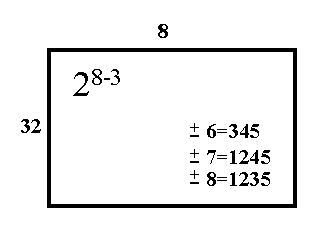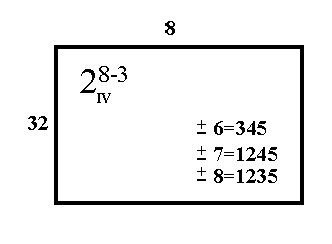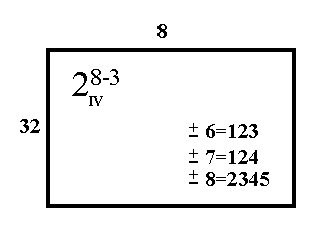5.
Process Improvement
5.3.
Choosing an experimental design
5.3.3.
How do you select an experimental design?
5.3.3.4.
Fractional factorial designs
5.3.3.4.4.
|
Fractional factorial design specifications and design resolution
|
|
|
Generating relation and diagram for the 28-3 fractional
factorial design
|
We considered the 23-1 design in the previous section and
saw that its generator written in
"I = ... " form is {I = +123}. Next we look at a one-eighth fraction
of a 28 design, namely the 28-3 fractional
factorial design. Using a diagram similar to
Figure 3.5, we have the following:
FIGURE 3.6: Specifications for a 28-3 Design

|
|
28-3 design has 32 runs
|
Figure 3.6 tells us that a 28-3 design has 32 runs, not
including centerpoint runs, and eight factors. There are three
generators since this is a 1/8 = 2-3 fraction (in general,
a 2k-p fractional factorial needs p
generators which define the settings for p additional factor
columns to be added to the 2k-p full factorial
design columns - see the following detailed description for the
28-3 design).
|
|
|
How to Construct a Fractional Factorial Design From the
Specification
|
|
Rule for constructing a fractional factorial
design
|
In order to construct the design, we do the following:
- Write down a
full factorial design in standard order for k-p
factors (8-3 = 5 factors for the example above). In the
specification above we start with a 25 full factorial
design. Such a design has 25 = 32 rows.
- Add a sixth column to the design table for factor 6, using
6 = 345 (or 6 = -345) to manufacture it (i.e., create the new
column by multiplying the indicated old columns together).
- Do likewise for factor 7 and for factor 8, using the appropriate
design generators given in Figure 3.6.
- The resultant design matrix gives the 32 trial runs for an
8-factor fractional factorial design. (When actually running
the experiment, we would of course randomize the run order.
|
|
Design generators
|
We note further that the design generators, written in `I = ...' form,
for the principal 28-3 fractional factorial design are:
{ I = + 3456; I = + 12457; I = +12358 }.
These design generators result from multiplying the "6 = 345"
generator by "6" to obtain "I = 3456" and so on for the other two
generators.
|
|
"Defining relation" for a fractional factorial design
|
The total collection of design generators for a factorial design,
including all new generators that can be formed as products of
these generators, is called a defining relation. There
are seven "words", or strings of numbers, in the defining
relation for the 28-3 design, starting with the original
three generators and adding all the new "words" that can be formed by
multiplying together any two or three of these original three words.
These seven turn out to be I = 3456 = 12457 = 12358 = 12367
= 12468 = 3478 = 5678. In general, there will be
(2p -1) words in the defining relation for a
2k-p fractional factorial.
|
|
Definition of "Resolution"
|
The length of the shortest word in the defining relation is called
the resolution of the design.
Resolution describes the
degree to which estimated main effects are aliased (or confounded)
with estimated 2-level interactions, 3-level interactions, etc.
|
|
Notation for resolution (Roman numerals)
|
The length of the shortest word in the defining relation for the
28-3 design is four. This is written in Roman numeral
script, and subscripted as
\( 2_{IV}^{8-3} \).
Note that the 23-1 design has
only one word, "I = 123" (or "I = -123"), in its defining relation since
there is only one design generator, and so this fractional factorial
design has resolution three; that is, we may write
\( 2_{III}^{3-1} \).
|
|
Diagram for a 28-3 design showing resolution
|
Now Figure 3.6 may be completed by writing it as:
FIGURE 3.7: Specifications for a
28-3, Showing Resolution IV

|
|
Resolution and confounding
|
The design resolution tells us how badly the design is confounded.
Previously, in the 23-1 design, we saw that the main effects
were confounded with two-factor interactions. However, main effects
were not confounded with other main effects. So, at worst, we have
3=12, or 2=13, etc., but we do not have 1=2, etc. In fact, a
resolution II design would be pretty useless for any purpose whatsoever!
Similarly, in a resolution IV design, main effects are confounded with
at worst three-factor interactions. We can see, in Figure 3.7, that
6=345. We also see that 36=45, 34=56, etc. (i.e., some two-factor
interactions are confounded with certain other two-factor interactions)
etc.; but we never see anything like 2=13, or 5=34, (i.e., main
effects confounded with two-factor interactions).
|
|
The complete first-order interaction confounding for the given
28-3 design
|
The complete confounding pattern, for confounding of up to two-factor
interactions, arising from the design given in Figure 3.7 is
34 = 56 = 78
35 = 46
36 = 45
37 = 48
38 = 47
57 = 68
58 = 67
|
|
|
All of these relations can be easily verified by multiplying the
indicated two-factor interactions by the generators. For example, to
verify that 38= 47, multiply both sides of 8=1235 by 3 to get 38=125. Then,
multiply 7=1245 by 4 to get 47=125. From that it follows that 38=47.
|
|
One or two factors suspected of possibly having significant
first-order interactions can be assigned in such a way as to
avoid having them aliased
|
For this
\( 2_{IV}^{8-3} \) fractional factorial design, 15 two-factor interactions
are aliased (confounded) in pairs or in a group of three. The remaining
28 - 15 = 13 two-factor interactions are only aliased with higher-order
interactions (which are generally assumed to be negligible).
This is verified by noting that factors "1" and "2" never appear in
a length-4 word in the defining relation. So, all 13 interactions
involving "1" and "2" are clear of aliasing with any other two factor
interaction.
If one or two factors are suspected of possibly having significant
first-order interactions, they can be assigned in such a way as to
avoid having them aliased.
|
|
Higher resoulution designs have less severe confounding, but
require more runs
|
A resolution IV design is "better" than a resolution III design because
we have less-severe confounding pattern in the 'IV' than in the
'III' situation; higher-order interactions are less likely to be
significant than low-order interactions.
A higher-resolution design for the same number of factors will, however,
require more runs and so it is 'worse' than a lower order design in that
sense.
|
|
Resolution V designs for 8 factors
|
Similarly, with a resolution V design, main effects would be confounded
with four-factor (and possibly higher-order) interactions, and
two-factor interactions would be confounded with certain three-factor
interactions. To obtain a resolution V design for 8 factors requires
more runs than the 28-3 design. One option, if estimating
all main effects and two-factor interactions is a requirement, is a
\( 2_{V}^{8-3} \) design. However, a 48-run alternative
(John's 3/4 fractional factorial) is
also available.
|
|
There are many choices of fractional factorial designs - some may
have the same number of runs and resolution, but different aliasing
patterns.
|
Note: There are other
\( 2_{V}^{8-3} \) fractional designs that can be derived starting with
different choices of design generators for the "6", "7" and "8" factor
columns. However, they are either equivalent (in terms of the number of
words of length of length of four) to the fraction with generators 6 = 345,
7 = 1245, 8 = 1235 (obtained by relabeling the factors), or they are
inferior to the fraction given because their defining relation contains
more words of length four (and therefore more confounded two-factor
interactions). For example, the
\( 2_{V}^{8-3} \) design with generators 6 = 12345, 7 = 135, and 8 = 245
has five length-four words in the defining relation (the defining relation
is I = 123456 = 1357 = 2458 = 2467 = 1368 = 123478 = 5678). As a result,
this design would confound more two factor-interactions (23 out of 28
possible two-factor interactions are confounded, leaving only "12", "14",
"23", "27" and "34" as estimable two-factor interactions).
|
|
Diagram of an alternative way for generating the 28-3 design
|
As an example of an equivalent "best"
\( 2_{V}^{8-3} \) fractional factorial design, obtained by "relabeling",
consider the design specified in Figure 3.8.
FIGURE 3.8: Another Way of Generating the 28-3
Design

This design is equivalent to the design specified in Figure 3.7 after
relabeling the factors as follows: 1 becomes 5, 2 becomes 8, 3 becomes
1, 4 becomes 2, 5 becomes 3, 6 remains 6, 7 becomes 4 and 8 becomes 7.
|
|
Minimum aberration
|
A table given later in this chapter
gives a collection of useful fractional factorial designs that, for a
given k and p, maximize the possible resolution and
minimize the number of short words in the defining relation (which
minimizes two-factor aliasing). The term for this is "minimum
aberration".
|
|
|
Design Resolution Summary
|
|
Commonly used design Resolutions
|
The meaning of the most prevalent resolution levels is as follows:
Resolution III Designs
Main effects are confounded (aliased) with two-factor interactions.
Resolution IV Designs
No main effects are aliased with two-factor interactions,
but two-factor interactions are aliased with each other.
Resolution V Designs
No main effect or two-factor interaction is aliased with any
other main effect or two-factor interaction, but two-factor
interactions are aliased with three-factor interactions.
|




